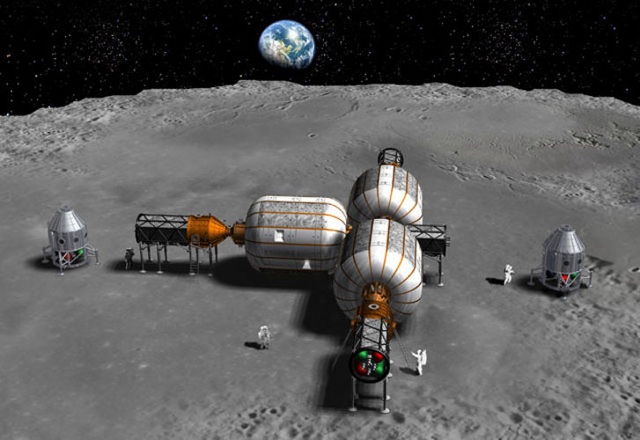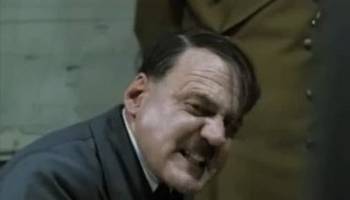The Latest from Boing Boing |  |
- HOWTO sneak Hitler onto YouTube
- Microwave ovens: The early years
- Space archaeologists!
- The Methuselah of elements
- Scientists mine YouTube to study effects of Salvia divinorum
- Gizmodo vs. critics of iPhone scoop
- Cooking with Salt & Fat
- Characters from Black Hole comic brought to life
- MAKE Volume 22: Remote Control
- Tim O'Reilly explains the Cloud
- Robert "Budget Suites" Bigelow's moon bases
- Photo of cancellation signs at Paris airport today
- Google will provide more data about government requests for user data
- Facebook further reduces privacy control for users
- Living "paintings"
- Mark Dery on Lady Gaga
- Hitler "Downfall" video meme is DMCA'd
- Man operates strip club in his basement
- Superintendent of schools to NJ governor: spare education
- Carbon offsets: fraud, exaggeration, and poorly run projects
- Dalek propaganda poster
- Kids and mobile phones: waiting for the surveillance shoe to drop
- Rectum-themed bar
- Steampunk figurines from Mauser Earth
- Magazine by and for the volcano-stranded
- Wikileaks founder Julian Assange to keynote 2600's HOPE conference, NYC Jul 16-18
- Amazon refuses to turn over customers' reading records to North Carolina tax department
- Performance Journalism
- Tiny otherworldly critters from the ocean depths
- Spying school took "thousands" of photos of students with covert webcam app, caught kids sleeping, half-dressed
| HOWTO sneak Hitler onto YouTube Posted: 20 Apr 2010 06:21 PM PDT Looking to game Google's copyright enforcement bot? That's the system that was used to hunt down rogue Hitler videos that remixed the bunker scene from Downfall, and it's pretty thick: YouTube's automated copyright filter |
| Microwave ovens: The early years Posted: 20 Apr 2010 05:38 PM PDT "The 1947 Radarange was a whopping six feet tall, weighed nearly 750 pounds, and required its own 220 volt electrical line and a dedicated water line for the cooling tube. It sold for $2000, or nearly $22,000 today." Eat Me Daily looks at the natural history of microwave ovens, from radar technology, to recipes for gourmet steamed pudding, to Joan Collins in her Dynasty finest. (Via Nicola Twilley.) |
| Posted: 20 Apr 2010 05:30 PM PDT  You know SETI, the nice folks out in California who scan the stars for radio transmissions, hoping to find evidence of E.T. You are probably also aware that this strategy hasn't exactly panned out. Now, some physicists are starting to pipe up, suggesting that SETI's problem maybe isn't so much a lack of aliens, but an over-dedication to searching for one, narrowly defined artifact of intelligent life. SETI is space archaeology, they say. And current practice is the equivalent of studying ancient Earth-bound civilizations using nothing but flint spear points—there's a lot of cultures you'd completely miss, because their technology was more advanced.
What to look for, instead? Scientists interviewed by The Economist suggested everything from pollution (the fact that there are Earth-based telescopes capable of studying the atmospheric composition of planets outside our solar system is mind-blowing enough on its own), to evidence of intelligent tampering with the energy output or aging process of distant suns. The Centauri Dreams blog gets into those later, sci-fi inspired possibilities a bit more in-depth. It seems like the key to this new approach is looking ahead in our own development, rather than behind or alongside, for searchable signals of intelligent life. And that's fascinating, not just for its possibility in the field of alien hunting, but for the questions it forces us to ask about Earth-bound technologies. Things like: Is there a better way we could be doing some of our basic techie activities, and how soon would it be able to supplant current methods? What might we be capable of in 1000 years, and what impact could that technology leave on our planet and our solar system? At the very least, I fully expect this line of inquiry to lead to some great, new literature—and maybe some usable tech ideas, too. (Via Lee Billings) Image courtesy Flickr user pasukaru76, via CC Previously: |
| Posted: 20 Apr 2010 04:34 PM PDT Samarium is a rare-earth element that can have a half-life of 106 billion years. You'll note that the entire freaking capital-U Universe, itself, is only around 14 billion years old. Thus, said long-lived isotope of samarium is one of the radioactive elements that gets pulled out when scientists want to date especially old chunks of rock—like ancient Martian meteorites. (Although, in that case, the samarium date is disputed.) |
| Scientists mine YouTube to study effects of Salvia divinorum Posted: 20 Apr 2010 04:23 PM PDT  I can't say the thought ever occurred to me, but apparently enough people think it's a good idea to get high, film themselves and post the results to YouTube that psychologists at San Diego State University were able to use the crowd-created video archive to do one of the first studies of the drug's behavioral impacts. Why study how people act when they're high on Salvia? Despite carrying a lot of the same cultural trappings as pot, Salvia is actually pretty unique, from a chemical standpoint. In fact, that was part of why it was legal in so much of the U.S. for so long—the chemical structure wasn't close enough to any already-outlawed drugs to be automatically covered as an analog under the same bans. Not surprisingly, Salvia's effects on the human brain are also very different, and science doesn't know much about those effects, says Mind Hacks' Vaughan Bell.
|
| Gizmodo vs. critics of iPhone scoop Posted: 20 Apr 2010 02:51 PM PDT  Gizmodo did a good thing and a bad thing yesterday. The good thing was publishing the gadget-blogging scoop of the decade--this summer's iPhone!--an honor shared by Engadget and a blogger named TEDream, both of whom scored earlier photographic ur-scoops of the new model. Gizmodo did a good thing and a bad thing yesterday. The good thing was publishing the gadget-blogging scoop of the decade--this summer's iPhone!--an honor shared by Engadget and a blogger named TEDream, both of whom scored earlier photographic ur-scoops of the new model.The bad thing was the ludicrously dramatic outing of the Apple engineer who lost the prototype. This earned Giz a well-deserved backlash, but we shouldn't let it overshadow the value of the original scoop. Checkbook journalism has its uses, and journalism of any kind is gold dust in the PR-fed world of gadget writing. BBG fans may be pleased to see that Joel Johnson, now at Gizmodo, agrees that the engineer's outing was a bad idea. He also kills another rumor doing the rounds--this being that the whole thing was a controlled leak--and repeats the point that access journalism sucks. You shouldn't trust the tech press PR corps who are happy with it any more than you trust Gizmodo. It's impossible to argue that "access journalism" has anything but a deleterious effect on the objectivity of journalists. Almost everyone in tech writing is compromised, but in this instance, only Gizmodo, Engadget and a single anonymous blogger have anything to show for it. It's hardly fair to complain about gadget writers rewriting press releases, then complain about how they get to real news, too. There's just not that much on the beat that isn't spooned out by PR people; if it takes a drunken employee's mishap and a paid-off thief, that's what it takes. Also, those fantasizing in public about someone prosecuting Gizmodo should put it away. It's disgusting. If you find Giz intolerable now, imagine it getting to mythologize its victimhood as a crusading poster child for press freedoms. God help us if Apple sues it or if it is prosecuted over this! Finally, you know what that SIM slot means? I think it means we're stuck with AT&T for another gen. Damn. Apple Didn't Leak the iPhone--And Why That Matters [Gizmodo] |
| Posted: 20 Apr 2010 01:52 PM PDT  Salt & Fat is a lovely food blog maintained by two guys, Neven Mrgan and Jim Ray, who spend their days developing software and web products and every other moment, apparently, thinking about food, and the making and eating of it. The name tips you that this isn't going to be a one of those oppressively good-for-you food-blog experiences. It's also not one of those sites that paints cooks as a kind of priesthood and cooking itself as something rarified, distant and difficult. In fact, as Ray noted in an introductory post on the day he and Mrgan started the site three months ago, Salt & Fat is a lovely food blog maintained by two guys, Neven Mrgan and Jim Ray, who spend their days developing software and web products and every other moment, apparently, thinking about food, and the making and eating of it. The name tips you that this isn't going to be a one of those oppressively good-for-you food-blog experiences. It's also not one of those sites that paints cooks as a kind of priesthood and cooking itself as something rarified, distant and difficult. In fact, as Ray noted in an introductory post on the day he and Mrgan started the site three months ago, ...people think cooking is too hard. Or takes too much time. I'd say the biggest marketing message is that we're constantly being told we're too busy (not necessarily too stupid, but I suppose that's an implication in all mass marketing) to bother to cook a meal, here's a meal-in-a-box full of sodium, preservatives and saturated high fructose whatnot. Let's put a stop to that.Today's entry on the cast-iron skillet is a good example of what the site does so well -- deliver a large quantity of useful information in a way that's brisk and sensible. There's a food-lovers' maxim to the effect that if you want to judge a new restaurant you shouldn't order the most complicated thing on the menu, you should order the simplest, because a kitchen that can turn out perfect scrambled eggs probably has its house in order. That's the sense you get from reading Ray's post on the iron skillet, which is the scrambled eggs of food blog topics -- the sort of basic entry that underpins everything else. When Ray answers, once and for all, the question of how to clean your iron skillet (and debunks the "Grandma never cleaned hers, not once, and she lived to be two hundred" myth) you know you're in good hands. Full disclosure: I clean my skillet just as Ray advises. It's a huge, hulking, heavy thing I bought at Target, because there's another old maxim -- I've seen it attributed to Michael Ruhlman, but haven't been able to confirm that independently -- that anybody who pays more than 12 bucks for a skillet is a freakin' idiot. |
| Characters from Black Hole comic brought to life Posted: 20 Apr 2010 02:38 PM PDT  Readers of Charles Burns' creepy comic book series Black Hole will recognize these faithful recreations of the yearbook photos of the monstrous teenagers from the series. The project was a collaboration between photographer Max Oppenheim and prosthetic artist Bill Turpin. Theoperators.net has the full series of photos, but unfortunately its Flash interface makes using the website as fun as brushing up against a Teddybear Cholla Cactus. UPDATE: Bless Spencer Cross' heart for finding the non-Flash blog entry. (Via Fantagraphics) |
| MAKE Volume 22: Remote Control Posted: 20 Apr 2010 01:14 PM PDT MAKE Volume 22 is on newsstands now! Automate your world with remote control. From pet care to power outlets, from toys to telepresence, we'll show you how to add a joystick, push-button, twist-knob, or timer to just about anything. Remote control projects in MAKE Volume 22 include:
In addition, you'll learn how to:
Plus, filmmaker and YouTube sensation PES shows how he creates his amazing stop-motion animation; and 8 top hobbyists and industry leaders tell what's hot in Remote Control. What on earth are foamies, Frankensteining, and aqua modeling? Get MAKE Volume 22 and find out.
Don't forget - subscribers can always read the digital edition here. |
| Tim O'Reilly explains the Cloud Posted: 20 Apr 2010 12:11 PM PDT Here's Tim O'Reilly on the future of Cloud computing and the "Internet of Things," speaking at the MySQL CE 2010 conference." As Bruce Sterling sez, "It looks like he's just telling disconnected alpha-geek anecdotes, in his customary, avuncular, visionary fashion. What Tim's really doing is throwing lit matches into his network. And boy is he the guru when it comes to doing that." O'Reilly MySQL CE 2010: Tim O'Reilly, "O'Reilly Radar" (via Beyond the Beyond) Previously:
|
| Robert "Budget Suites" Bigelow's moon bases Posted: 20 Apr 2010 12:34 PM PDT  Hotel hotshot and aerospace entrepreneur Robert Bigelow announced his plans for a Budget motel, er I mean, inflatable base on the moon. Meant for 18 astronauts to call temporary home, the base would be assembled in space before piloted to the lunar surface. A solar array field would power the habitat, which Bigelow suggests could have a minimum volume of 2,100 cubic meters, twice that of the International Space Station. The company is also designing habitats for the International Space Station and also Lagrangian Point L1, halfway between Earth and the moon, as a way station for trips to Mars. From Space.com: "I see a huge sea change in using expandable systems," Bigelow told SPACE.com in an exclusive interview. "I feel this architecture is fundamentally safer, less expensive, and can save an awful lot of time....""Private Moon Bases a Hot Idea for Space Pioneer" (Thanks, Jacques Vallee!) |
| Photo of cancellation signs at Paris airport today Posted: 20 Apr 2010 12:25 PM PDT  I'm at the airport in Paris waiting for my flight to Dubai, which will presumably get me out from under the volcano ashes. What an amazing journey this has been. Once I get to safety, I will process it all and tell you guys about my escape. For now, please enjoy this photo showing the flights going out and not going out of Charles de Gaulle. Here's to hoping that mine does not turn into a red Canceled sign. I'm at the airport in Paris waiting for my flight to Dubai, which will presumably get me out from under the volcano ashes. What an amazing journey this has been. Once I get to safety, I will process it all and tell you guys about my escape. For now, please enjoy this photo showing the flights going out and not going out of Charles de Gaulle. Here's to hoping that mine does not turn into a red Canceled sign. Image via Joi's Flickr |
| Google will provide more data about government requests for user data Posted: 20 Apr 2010 11:25 AM PDT A great move by Google today: The search giant is "launching a new Government Requests tool to give people information about the requests for user data or content removal we receive from government agencies around the world. For this launch, we are using data from July-December, 2009, and we plan to update the data in 6-month increments. Read this post to learn more about our principles surrounding free expression and controversial content on the web." (via Jake Appelbaum) |
| Facebook further reduces privacy control for users Posted: 20 Apr 2010 11:19 AM PDT The EFF reports on another ratcheting back of data privacy control for Facebook users: "Today, Facebook removed its users' ability to control who can see their own interests and personal information. Certain parts of users' profiles, 'including your current city, hometown, education and work, and likes and interests' will now be transformed into 'connections,' meaning that they will be shared publicly. If you don't want these parts of your profile to be made public, your only option is to delete them." |
| Posted: 20 Apr 2010 01:19 PM PDT  Alexa Meade, 23, is a Washington, DC-based artist who paints on top of her subjects and puts them in real life settings. (No, you can't see the pixels. This is real.) From Meade's artist statement: Alexa Meade (Thanks to Hi-Fructose and all who pointed me to this) |
| Posted: 20 Apr 2010 12:16 PM PDT Is Lady Gaga dumb? This is the question that Mark Dery ponders, as only Dery can, in his latest True/Slant essay: "Aladdin Sane Called. He Wants His Lightning Bolt Back: On Lady Gaga." The point-of-entry is a New Yorker essay from last year by music critic Sasha Frere-Jones in which he raised the eternal inquiry, "How not dumb is Gaga?" Dery's answer may not not surprise you. From True/Slant: "Aladdin Sane Called. He Wants His Lightning Bolt Back: On Lady Gaga" |
| Hitler "Downfall" video meme is DMCA'd Posted: 20 Apr 2010 10:44 AM PDT Copyright claims against various Hitler "Downfall" parody videos have resulted in the removal of these videos from YouTube. The DMCA claimant is Constantin Films, the German production company which owns rights to the 2004 film Der Untergang ("Downfall"), from which the source video is excerpted. Boy, is Hitler ever gonna be pissed. |
| Man operates strip club in his basement Posted: 20 Apr 2010 12:20 PM PDT Jay Thunderbolt owns a Detroit strip club. In his basement. He runs the whole thing himself, and makes sure that Club Thunderbolt is open 24/7, by appointment. From the Metro Times: "Nothing but a G-string" (Thanks, Heather Sparks!) |
| Superintendent of schools to NJ governor: spare education Posted: 20 Apr 2010 10:09 AM PDT David C Verducci, the Superintendent of Schools of Glen Rock, NJ, has sent a letter to state governor Chris Christie, asking him to spare education in the state's round of econopocalyptic cost-cutting, explaining in passionate and stirring language the need to commit to education even in bad times. Make us -ALL of the stakeholders here- a partner in the process.Open letter from Superintendent of Schools of Glen Rock, NJ to Gov. Christie (PDF) (Thanks, Michael!) Previously: |
| Carbon offsets: fraud, exaggeration, and poorly run projects Posted: 20 Apr 2010 10:03 AM PDT Today, the Christian Science Monitor published a damning, six-part investigation into carbon credits, and concluded that they are a hive of fraud and villainy, calling them "a 'Wild West' market ripe for fraud, exaggeration, and poorly run projects that probably do little to ease global warming." Buying carbon offsets may ease eco-guilt but not global warming (Image: DSC02702, a Creative Commons Attribution Share-Alike (2.0) image from kareneliot's photostream) Previously:
|
| Posted: 20 Apr 2010 09:56 AM PDT  Arkizzle sez, "The BBC has put up a great quality version of the propaganda-style, Daleks' To Victory! poster, from the newest Doctor Who episode." Previously: |
| Kids and mobile phones: waiting for the surveillance shoe to drop Posted: 20 Apr 2010 09:47 AM PDT  The good folks at the Pew Internet and American Life project have published their latest report, looking at the remarkable transformation that the mobile phone continues to effect on the lives of teenagers. The good folks at the Pew Internet and American Life project have published their latest report, looking at the remarkable transformation that the mobile phone continues to effect on the lives of teenagers. The Boomers' adolescent lives were transformed by the auto, which gave kids the mobility to get away from their parents' oversight -- the emblem of this transformation being the teen couple screwing in the back seat at a drive-in (protected from unwanted pregnancy by the Pill). This is often cited as an example of the wild directions in which the Law of Unintended Consequences can hare off. But I always thought that this account of the car was incomplete, because it left out one very important change to adolescent life in America: the widespread adoption of driving licenses by teens meant that for the first time in American history, practically every adolescent could be expected to carry government-issued identity papers. Today, in 2010, if I were asked to evaluate which second-order effect -- the sexual revolution or the identity card -- was more profound, it'd be hard to pick one. But the effect of identity papers took a lot longer to be felt. The ubiquitous mobile phone in adolescent hands has meant an enormous increase in adolescent freedom to communicate and to form groups to take action. But it's also meant an unprecedented (and as yet, largely unfelt) increase in the amount of surveillance data available to parents and authority figures, from social graphs of who talks to whom to logs of movement to actual records of calls and texts. Will we wake up in 20 years and say, "Christ, how could we have spent all that time talking about how kids were sending each other texts without taking note of the fact that we'd given every teen in America his own prisoner tracking cuff and always-on bug?" * Text messaging has become the most frequent way that teens reach their friends, surpassing face-to-face meetings, email, instant messaging and voice calling as a daily communications tool.Teens and Mobile Phones Previously: |
| Posted: 20 Apr 2010 12:23 PM PDT  The BarRectum was an actual bar built inside a giant anatomical model representing the human digestive system, from tongue to anus. Dutch design firm Atelier Van Lieshout created it several years ago for the Vienna Museum Quarter. From the project description: BarRectum 2005 (via Fortean Times) |
| Steampunk figurines from Mauser Earth Posted: 20 Apr 2010 09:33 AM PDT  Miss Ticklenot (shown here) is one of several new steampunk figurines from Mauser Earth, 5cm high (1/35 scale). The whole collection is just terrific, and would make a great addition to your tabletop conquest-map of Europe or your carefully arranged desk-toy shrine. MAUSER EARTH (via Super Punch) |
| Magazine by and for the volcano-stranded Posted: 20 Apr 2010 09:14 AM PDT Like hundreds of thousands (millions?) of people around the world, I've been stranded by the Iceland volcano, caught on the North American landmass and unable to return home to London. We're fine, but incredibly busy trying to keep up with our commitments at 9,000 miles' remove. Andrew Losowsky is also one of the stranded, and he's starting a (short-lived, I hope!) magazine made by and for stranded people around the world: Magtastic Blogsplosion (via Kottke) (Image: Incredible Iceland volcano photo, a Creative Commons Attribution (2.0) image from paulmiller's photostream) Previously: |
| Wikileaks founder Julian Assange to keynote 2600's HOPE conference, NYC Jul 16-18 Posted: 20 Apr 2010 09:06 AM PDT Julian Assange, the mysterious and suicidally brave force behind Wikileaks, will keynote at The Next HOPE, the annual hacker/tech conference summertimes in NYC by the folks behind 2600 Magazine. This year's event is July 16-18. Julian Assange To Give Keynote Address at The Next HOPE Previously:
|
| Amazon refuses to turn over customers' reading records to North Carolina tax department Posted: 20 Apr 2010 09:02 AM PDT North Carolina's tax department wants to ding NC residents for sales tax on purchases from out-of-state etailers like Amazon.com, so they've asked Amazon to cough up a list of everything its NC customers have bought -- books, sex-toys, steaks, CDs, whatever. Amazon's taken the high-road, and has gone to court to protect its customers' privacy. Good on ya, Amazon! The lawsuit says the demand violates the privacy and First Amendment rights of Amazon's customers. North Carolina's Department of Revenue had ordered the online retailer to provide full details on nearly 50 million purchases made by state residents between 2003 and 2010.Amazon fights demand for customer records (via /.) Previously: |
| Posted: 20 Apr 2010 10:48 AM PDT  Just to be clear, the creators of Pop-Up Magazine aren't trying to outdo print mags. The San Francisco event they've invented--the third issue happened this weekend to a sold-out Herbst Theater--is a stage show aimed to bring the best of magazines into "the medium of live," as Editor-in-Chief Doug McGray told me (his collaborators are Derek Fagerstrom, Lauren Smith, Maili Holiman, Evan Ratliff, and Dave Cerf). Pop-Up's got a masthead and table of contents, shorts, features, even integrated ads, and many of the contributors make their livings through words and images on the page (there are also film-makers and radio producers). There they all were, behind not laptops but a podium, spot-lit and performing. Disclosures: Doug's a friend, and I worked with my Youth Radio colleague Brandon McFarland on his contribution to Pop-Up's first issue. But this time around, from my vantage point in the audience, I couldn't help but notice five things Pop-Up does better than print. • Urgency: The show sold out in minutes (while print mags struggle to hold their advertisers). And then there was an after-party (see #5) that required special tickets of its own. I felt myself getting physically riled up booking my own tickets, as each little "available seat" icon blinked off before my eyes. Hate to say it, but that kind of flurry changes the way you think about an evening of journalism. • Ephemerality: It's live, as in, no digital record. There's novelty now in content that's over and gone once it's done its thing. • Spontaneity: There was this moment early in the show when the writer Jennifer Kahn was wrapping up her story about her 80-something-year-old dad's unlikely ascent in competitive weightlifting. When a home-video clip of his win ended, the man himself strolled onto the stage, trophy raised. It was pretty awesome, that unexpected shift from media to live. Across the show, the mix of off-the-cuff, scripted, and produced elements meant you never knew what was going to happen next. • Draftiness: Pop-Up is unrehearsed. Many of its segments are built around bits and pieces of things that either aren't finished or didn't make a final cut. Like Josh Harkinson's photo presentation of his canoe trip through a hideously polluted Texas waterway. He closed by saying he'd pitched the story to Outside Magazine and they said no, they don't do stories like that. Moments like that one give live-audience "readers" a feeling that they're in on a process that otherwise only happens behind closed doors. • Party: For his segment on food justice, the writer and chef Bryant Terry showed slides of his Oakland neighborhood's backyard edible gardens, which included Meyer lemon trees, which happened to be a main ingredient in a drink he then proceeded to mix onstage and plug as the special cocktail that would be served during the after-party in the Herbst's soaring green room. I've never been to a print magazine release party, and I'm sure they're fabulous. But the difference here is, there's less of a gap, format and vibe-wise, between the content and the celebration. So, given all that Pop-Up has appropriated from print magazines, now I'm wondering, what can print mags steal back? |
| Tiny otherworldly critters from the ocean depths Posted: 20 Apr 2010 08:57 AM PDT  From the mysterious and unplumbed depths of the ocean, a National Geographic gallery of tiny sea critters inventoried in the recent Census of Marine Life. These otherworldly beasties are weird, wonderful and captivating. Pictures: Hard-to-See Sea Creatures Revealed (Thanks, Marilyn!) Previously:
|
| Posted: 20 Apr 2010 08:56 AM PDT More details have come to light in the case of the Lower Merion School District spying on its students with covert laptop webcam software. The school district of the affluent Philadelphia suburb issued mandatory laptops to its students, each one loaded with software that could covertly activate the laptops' webcams, supposedly as a security measure to help recover stolen laptops). Students were required to carry and use the laptops, forbidden from using their own computers in school, and prohibited from modifying the software on their machines. The school claims that it only activated the webcam spying software on rare occasions, but this is contested by parents. One student, Blake Robbins, was called in for a disciplinary meeting for "popping pills" while at home (Robbins says he was eating Mike & Ike's candies). The revelation that the school had been watching him remotely resulted in a parent lawsuit. Now, the parents' lawyer says that "thousands" of covert photos and screenshots were taken in students' homes. These photos included students in various states of undress, sleeping, and partaking in other private activities. Shown below, a photo of Blake Robbins sleeping, covertly captured by his school laptop, released by the family's lawyer. School District Allegedly Snapped Thousands of Student Webcam Spy Pics Robbins v Lower Merion School District filing (PDF) Previously:
|
| You are subscribed to email updates from Boing Boing To stop receiving these emails, you may unsubscribe now. | Email delivery powered by Google |
| Google Inc., 20 West Kinzie, Chicago IL USA 60610 | |

 Mark Smitelli has poked around at the system, uploading copies of the copyrighted song "I Know What Boys Like," sonically altered in various ways: compressing or expanding the time, lowering or raising the pitch, adding noise, etc. Mark runs the complete results, but to roughly summarize: Altering parameters more than 5% often seems to fool the Identifier, and using less than 30 seconds also seems to let the clip slip through the rule-bound robot's shiny little nets. Playing clips in reverse confused the Identifier, but stripping out everything except the vocals did not.
Mark Smitelli has poked around at the system, uploading copies of the copyrighted song "I Know What Boys Like," sonically altered in various ways: compressing or expanding the time, lowering or raising the pitch, adding noise, etc. Mark runs the complete results, but to roughly summarize: Altering parameters more than 5% often seems to fool the Identifier, and using less than 30 seconds also seems to let the clip slip through the rule-bound robot's shiny little nets. Playing clips in reverse confused the Identifier, but stripping out everything except the vocals did not. 
 The reverse trompe l'oeil series is Alexa Meade's spin on reality. Alexa has invented a painting technique that makes 3 dimensional space look flat, blurring the lines between illusion and reality.
The reverse trompe l'oeil series is Alexa Meade's spin on reality. Alexa has invented a painting technique that makes 3 dimensional space look flat, blurring the lines between illusion and reality.  Most of the comment-thread flame wars between Gaga's Kiss Army of "little monsters," as the Lady calls her devout fans, and her no less devout haters are ignited by the Great Debate: Is she a rarified being who has more talent in her clitoral hood than you can even dream of, little man? Whose Art for Art's Sake raptures us out of our stonewashed lives, into a disco ball-flecked Bubble World, a Studio 54 in the Sky where gay teens, pillow-biting emo boys, and high-school weirdos are waved into the VIP lounge while all the Mean Girls and haters mill outside, crazed with envy? Or is she just some Tisch drop-out who watched Grease one too many times, pickled her brain in Britney, and now thinks she's some cross between Madonna and Leigh Bowery, just because she forgets to wear pants and name-checks The Night Porter (Sontag's "Fascinating Fascism" for people who don't read)? In other words, is Lady Gaga the last, best hope for pop smart enough to beat the Society of the Spectacle at its own game, sell out with a shamelessness that would shock the pants off her patron saints (Warhol and Dali, who perfected the complimentary notions of self as brand and art as marketing) and still snooker a generation of cultural-studies profs and nth-wave feminists into a deconstructive swoon about her Judith Butler-approved gender performativity? Or is she something thuddingly dumber: Donatella Versace in the remake of Blow-Up? Liza Minelli in a Vegas revue inspired by The Reluctant Astronaut? Perez Hilton sings the Human League songbook? Is she pop, or Pop Art? In on the joke, or just a joke?
Most of the comment-thread flame wars between Gaga's Kiss Army of "little monsters," as the Lady calls her devout fans, and her no less devout haters are ignited by the Great Debate: Is she a rarified being who has more talent in her clitoral hood than you can even dream of, little man? Whose Art for Art's Sake raptures us out of our stonewashed lives, into a disco ball-flecked Bubble World, a Studio 54 in the Sky where gay teens, pillow-biting emo boys, and high-school weirdos are waved into the VIP lounge while all the Mean Girls and haters mill outside, crazed with envy? Or is she just some Tisch drop-out who watched Grease one too many times, pickled her brain in Britney, and now thinks she's some cross between Madonna and Leigh Bowery, just because she forgets to wear pants and name-checks The Night Porter (Sontag's "Fascinating Fascism" for people who don't read)? In other words, is Lady Gaga the last, best hope for pop smart enough to beat the Society of the Spectacle at its own game, sell out with a shamelessness that would shock the pants off her patron saints (Warhol and Dali, who perfected the complimentary notions of self as brand and art as marketing) and still snooker a generation of cultural-studies profs and nth-wave feminists into a deconstructive swoon about her Judith Butler-approved gender performativity? Or is she something thuddingly dumber: Donatella Versace in the remake of Blow-Up? Liza Minelli in a Vegas revue inspired by The Reluctant Astronaut? Perez Hilton sings the Human League songbook? Is she pop, or Pop Art? In on the joke, or just a joke?  There's no cover charge. Customers can order different strippers out of the company catalog -- a photo album full of seedy-looking Polaroids. Each page features one of his strippers in three poses -- bent over, spread eagle and come hither. There are dozens of girls to choose from.
There's no cover charge. Customers can order different strippers out of the company catalog -- a photo album full of seedy-looking Polaroids. Each page features one of his strippers in three poses -- bent over, spread eagle and come hither. There are dozens of girls to choose from.  An investigation by The Christian Science Monitor and the New England Center for Investigative Reporting has found that individuals and businesses who are feeding a $700 million global market in offsets are often buying vague promises instead of the reductions in greenhouse gases they expect.
An investigation by The Christian Science Monitor and the New England Center for Investigative Reporting has found that individuals and businesses who are feeding a $700 million global market in offsets are often buying vague promises instead of the reductions in greenhouse gases they expect.  BarRectum, Arsch Bar, Asshole Bar, Bar Anus. While the translations sound different, the form is universally recognizable. The bar takes its shape from the human digestive system: starting with the tongue, continuing to the stomach, moving through the small and the large intestines and exiting through the anus. While BarRectum is anatomically correct, the last part of the large intestine has been inflated to a humongous size to hold as many drinking customers at the bar as possible. The anus itself is part of a large door that doubles as an emergency exit.
BarRectum, Arsch Bar, Asshole Bar, Bar Anus. While the translations sound different, the form is universally recognizable. The bar takes its shape from the human digestive system: starting with the tongue, continuing to the stomach, moving through the small and the large intestines and exiting through the anus. While BarRectum is anatomically correct, the last part of the large intestine has been inflated to a humongous size to hold as many drinking customers at the bar as possible. The anus itself is part of a large door that doubles as an emergency exit. If you're out there and interested, email me and tell me what you do. I'll then give you an assignment to complete today/tomorrow. Depending on how long this thing lasts, we'll work the rest of it out from there. The copyright will remain yours on anything you produce, I just ask for permission to include it in the currently-untitled ashcloud magazine (working titles include Grounded, SkyFail and Someday We'll Fly Away.)
If you're out there and interested, email me and tell me what you do. I'll then give you an assignment to complete today/tomorrow. Depending on how long this thing lasts, we'll work the rest of it out from there. The copyright will remain yours on anything you produce, I just ask for permission to include it in the currently-untitled ashcloud magazine (working titles include Grounded, SkyFail and Someday We'll Fly Away.)  Over the years and particularly within the past couple of weeks, Julian has demonstrated some of the key values of those in the hacker and journalist community who strive to get real information out of the hands of bureaucracy and cover-ups and share it with the rest of the world, all the while protecting the sources.
Over the years and particularly within the past couple of weeks, Julian has demonstrated some of the key values of those in the hacker and journalist community who strive to get real information out of the hands of bureaucracy and cover-ups and share it with the rest of the world, all the while protecting the sources.  "Discovery to date has now revealed that thousands of webcam pictures and screen shots (.pdf) have been taken from numerous other students in their homes, many of which never reported their laptops lost or missing," attorney Mark Haltzman wrote in a Thursday federal court filing...
"Discovery to date has now revealed that thousands of webcam pictures and screen shots (.pdf) have been taken from numerous other students in their homes, many of which never reported their laptops lost or missing," attorney Mark Haltzman wrote in a Thursday federal court filing...
No comments:
Post a Comment